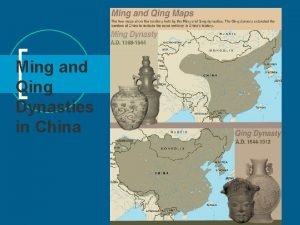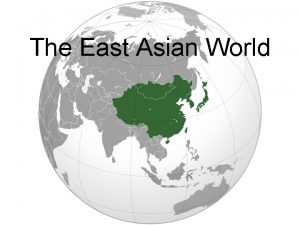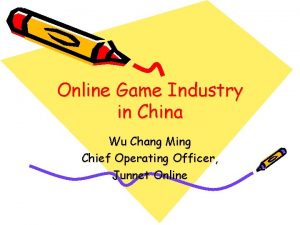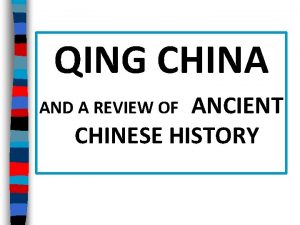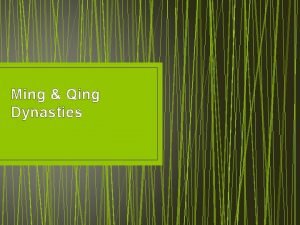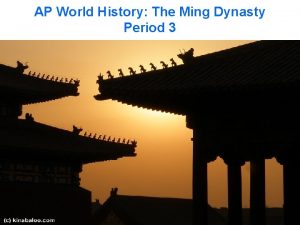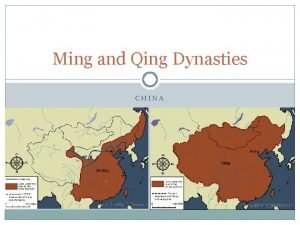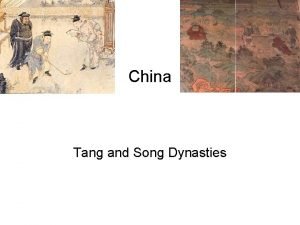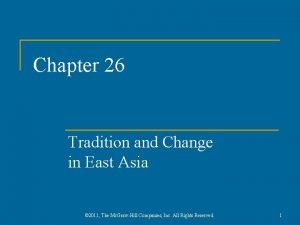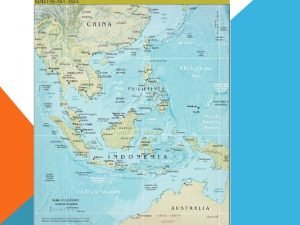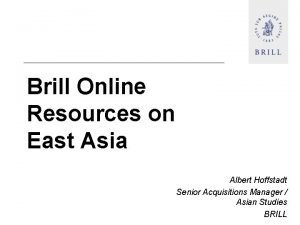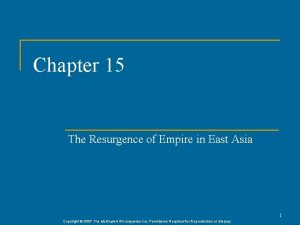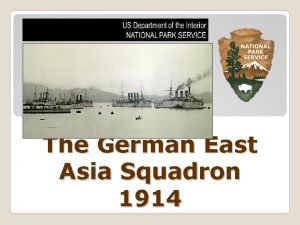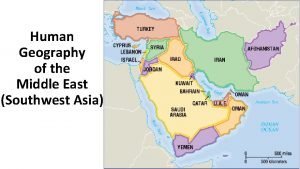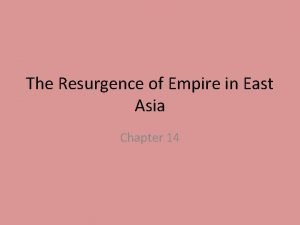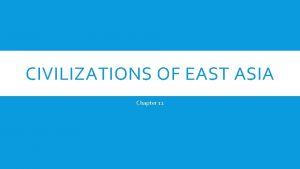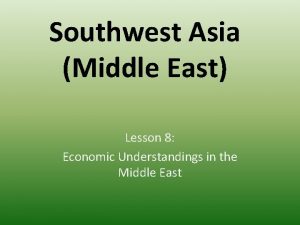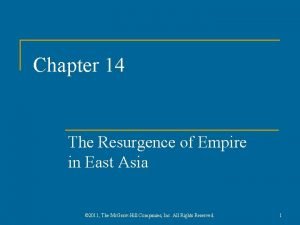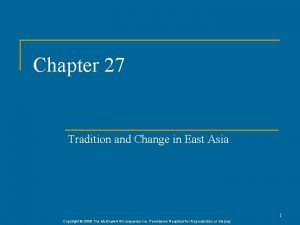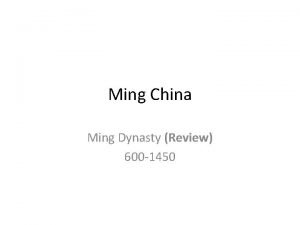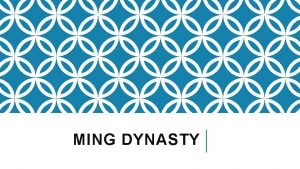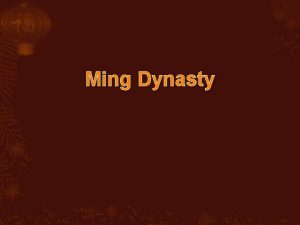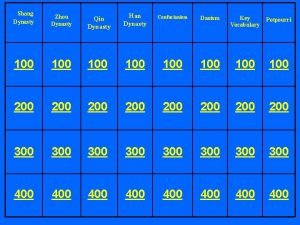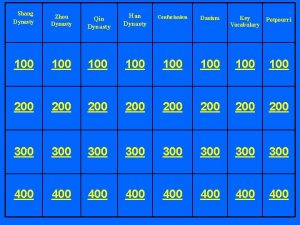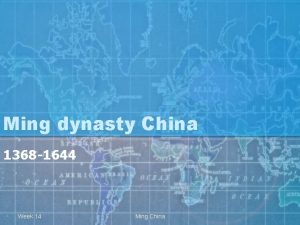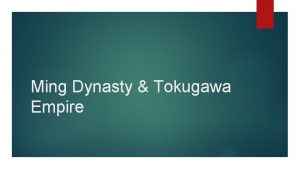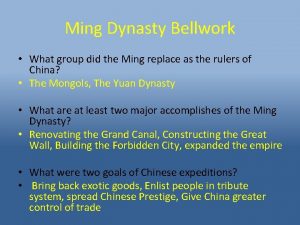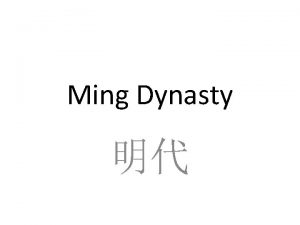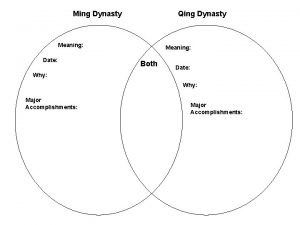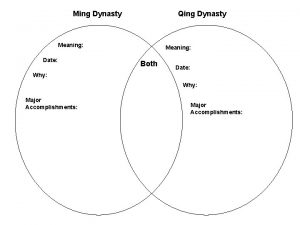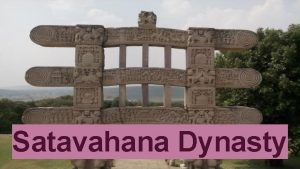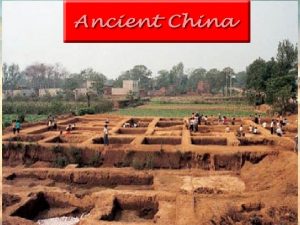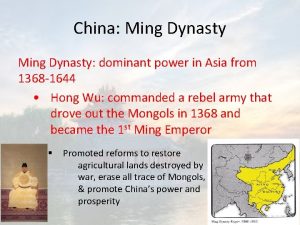EAST ASIA EAST ASIA THE LATE MING DYNASTY























- Slides: 23

EAST ASIA

EAST ASIA: THE LATE MING DYNASTY Dynasty began with overthrow of Mongols and lasted 300 years Early years Government effective Population and food grew Commercial activity continued Ming emperors wary of outsiders Chinese tendency to protect culture Silk and porcelain highly prized Rulers didn’t turn backs completely on highly profitable commerce

EAST ASIA: THE LATE MING DYNASTY POLITICAL CHARACTERISTICS Palace eunuchs served as emperor’s eyes and ears (spy) with direct access to emperors Expanded forbidden city Examination system revived Required extensive knowledge of Confucian thought Ming armies large, good leadership Firearms not as advanced as the West

ECONOMIC PROGRESS AND TECHNOLOGICAL RESISTANCE Commercial activity strong in China 16 th C Large % of people engaged in trade and manufacture Portuguese traded New World silver for luxury goods; behavior considered offensive Silk and porcelain are still popular Urban areas grew under Ming; inland port cities Ming not interested in technical innovation Europeans had adapted and improved many early Chinese inventions Gunpowder and printing In quest to preserve identity, Chinese took little notice of technological advances that would prove

THE LATE MING DYNASTY TRADE AND CULTURAL CONTACTS WITH OUTSIDERS High point in cultural and commercial relations with Japan Shoguns embraced Chinese culture Japanese and Chinese pirates raided together Trade contacts with westerners limited Important opening for Europe was Ming tolerance of Christian missionaries who shared western technology Ming found European visitors amusing and interesting

THE LATE MING DYNASTY TRADE AND CULTURAL CONTACTS WITH OUTSIDERS Jesuits brought European innovations as gifts; took advantage of good will Devised ways to convince emperor of similarities between Confucianism and Christianity Number of converts low Eventually Pope became alarmed about comparisons with Confucianism and Christianity; Jesuit mission ended Results: Jesuits failed in goal of a Christian China but opened country to European influence

THE LATE MING DYNASTY THE DECLINE OF THE MING Problems defending borders Nomadic groups successful forays across Great Wall Weak emperors Corruption (particularly among the long-resented eunuchs) Court factions bickering for the emperor's favor Peasant rebellions Manchurians won the Mandate of Heaven Barbarians from the north Renamed empire the Qing (pure) Dynasty Founded and maintained a brilliant new era for China

Manchu gained control of Beijing and began campaign to conquer rest of Ming territory By late 18 th C China reached largest size in history; largest country in the world • Transition from Ming to Qing not as difficult as transitions between dynasties in earlier periods • Some gave their support to Manchu in taking over government QING DYNASTY

THE QING DYNASTY POLITICAL ORGANIZATION Qing encouraged separation between Manchu and Chinese Confucians subjugated to the victors Highest posts filled by Manchu Confucian scholar-gentry kept most positions in bureaucracy Manchu rulers wanted to preserve ethnic identity Forbade intermarriage Chinese men forced to shave front of heads and grow queue as a sign of submission to dynasty Civil service exams became more competitive with tests given on district, provincial, and metropolitan levels Most student took the test several times

THE QING DYNASTY POLITICAL ORGANIZATION Emperor led secluded but privileged life in Forbidden City “Theatre state” apparent Sumptuous palace and customs Emperor’s clothing Kowtow (three separate kneelings) Manchu dynasty strengthened by two strong emperors Kangxi and Qianlong - Together rule spanned 130 years Cemented prosperous, powerful, culturally rich empire Both sophisticated Confucian scholars Managed Chinese economy efficiently Kangxi a talented military leader Qianlong brought such prosperity that he cancelled tax collections four times

THE QING DYNASTY ECONOMIC AND SOCIAL CHARACTERISTICS Prosperity based upon Agriculture; high yields from new methods Rice, wheat, millet New foods from Americas Maize, sweet potatoes, peanuts raised on soil not appropriate for previous crops New foods sustained rapid increase in population Population outpaced food supply but not evident before 1750 Population growth supported by trade and influx of American silver Chinese workers produced silk, porcelain, and tea New silver supplies generally helped Chinese economy (contrast to Muslims)

THE QING DYNASTY SOCIAL CHARACTERISTICS Patriarchal society Control over women probably increase late Ming to Qing Confucian ideals strong Preference for male children clear (only males could take civil service exam which could boost family status) Women encouraged to commit suicide after husbands died Foot binding popular Women could not divorce husbands Men could put wives aside for disobedience or adultery

THE QING DYNASTY SOCIAL CHARACTERISTICS At the top is the Emperor and his family High status of scholar bureaucrats Distinctive clothing Income from government service Lived in urban areas Owned land that brought additional income Below gentry were peasants and artisans – honest work Merchants with the lowest status since peasants more worthy Lower classes often called ‘mean people’ which included slaves, indentured servants, and beggars

THE QING DYNASTY CULTURAL INFLUENCES Beyond Neoconfucianism a rich cultural life emerged in philosophy, literature, and history Emperors supported printing and distribution of materials Popular novels circulated two often best know to novels are the Book of the Golden Lotus and the Dream of the Red Chamber Porcelain became major art form during Ming and Qing Vases, decorative bowls, painted scrolls and screens in demand Prices rose and production increased Prosperous Chinese also filled homes with goods; many items did not go to international trade By 1700’s many Chinese could read and children went to schools and academies Calligraphy, painting, and poetry more prized than math and science

Change Over time China’s Long History 8000 -600 BCE Earliest know dynasty emerged 1500 BCE in Yangzi and Huang He River Valleys. Veneration of family ancestors; emphasis on importance on writing and learning. Shang overthrown by Zhou; instituted belief in mandate of heaven 600 BCE – 600 CE Confucianism, Daoism, Legalism developed during Zhou dynasty. Shi Huangdi unified China as short-lived Qin Dynasty under Legalism; followed by Han based on Confucianism. Dynastic cycle patterns well established 600 -1450 Chaos followed Sui dynasty, then long era of Tang emerged. Buddhist influences, Confucians regained control. Neoconfucianism. Tang and Song culturally rich, military strength greater with Tang. Song defeated by Mongols, established Yuan overthrown by Ming; rebuilt Chinese cultural institutions. Ming had mixed feeling about outside world. 1450 - 1750 Ming strong early, lost control to Manchus – the Qing. Strengthened China with army and competent rulers. Largest and one of strongest countries 1750.

Japan organized politically and economically into feudalistic hierarchies • Emperor ruled in name only • Shogun (top military authority) wielded most real power • Powerful territorial lords, daimyos, had great deal of local control Political power fragmented as a result Each daimyo pledged allegiance to the shogun as overlord JAPAN

EAST ASIA: THE TOKUGAWA SHOGUNATE Daimyos met under leadership of Tokugawa Ieyasu to establish centralized government in 1603 Also called Tokugawa bakufu; tent government Implying that it was a temporary replacement for the power of the emperor Tokugawa controlled Japan until 1867 Daimyos still retained power and authority Shogun’s authority based on military might To check daimyo’s power; alternate attendance Required daimyos to spend every other year at Tokugawa court Weakened daimyos in two ways https: //www. youtube. com/watch? v Wealth affected because they had to maintain two households =Nosq 94 o. Cl_M Start at 4: 50 Daimyos absence from lands impaired ability to establish power base at home

THE TOKUGAWA SHOGUNATE ECONOMIC AND SOCIAL CHANGE Political unification encouraged economic growth Growth rooted in agriculture Water control Irrigation Use of fertilizer Similar to China Yields of rice and other foods meant rapid population growth Curbed by birth control, late marriage, abortion, infanticide Japan had limited space available Limited geography , mountainous land, poor soil

THE TOKUGAWA SHOGUNATE ECONOMIC AND SOCIAL CHANGE Social hierarchy influenced by Confucianism Obedience and responsibilities of people of unequal ranks Ruling elites included Shogun Daimyos Samurai Middle class Peasants and artisans Merchants at bottom As peace settled and trade flourished, merchants became more prosperous and were among wealthiest Samurai left with nothing to do in times of peace Strict social hierarchy prevented samurai from other professions; many fell into debt

THE TOKUGAWA SHOGUNATE ARTS AND LEARNING Culture shaped by Confucianism, Buddhism, and Shintoism Elite influenced by Neoconfucianism Buddhism and Shintoism more influential among common people Shintoism -devotion to invisible spiritual beings and powers who appreciate the interest in people and want humans to be happy. If they are treated properly they will intervene in ones life to bring benefits like health, business success, and good exam results. Shintoism promoted as important source of Japanese identity

THE TOKUGAWA SHOGUNATE ARTS AND LEARNING Literacy rates high (less characters than Chinese) Poetry, novels, social satires, and kabuki plays most common forms of urban literature Kabuki Drama with singing, dancing, and elaborate staging Setting for plays often the ‘floating worlds’ Teahouses Public baths Brothels Allowed people to escape rigid public decorum Bunraku; puppet theatre also popular

JAPAN AND THE EUROPEANS Japanese attempting to unify Japan; European ships on their way to the islands by mid 16 th c European traders and missionaries Trade and conversion main goals Priests had some success; focus on converting daimyos Hideyoshi ordered missionaries to leave the island Soon persecuting Catholic priests and native converts Ieyasu, first Tokugawa shogun, banned Christianity 1614 Drove missionaries out; killed any who refused to go Converts tortured, imprisoned, executed if wouldn’t renounce Tokugawa regime seriously restricted foreign traders

JAPANESE ISOLATIONISM Japanese tended to be isolated by geography Choppy waters of Korean Strait made contact of invasion difficult Geography no longer counted on for Japanese independence Shoguns used power to Expel Catholics Forbid Christianity Limit Dutch and Chinese ships Ban western books Allow foreigners in small, restricted areas Allowed shoguns to concentrate on strengthening internal control
 Ming dynasty
Ming dynasty The ming dynasty ended rule of china.
The ming dynasty ended rule of china. Rise of the ming dynasty
Rise of the ming dynasty Ming dynasty game online
Ming dynasty game online Ming dynasty trade routes
Ming dynasty trade routes Mingoch
Mingoch Ming and qing dynasty
Ming and qing dynasty The wing dynasty menu
The wing dynasty menu Shang dynasty timeline
Shang dynasty timeline Ming dynasty time period
Ming dynasty time period Ming and qing dynasty venn diagram
Ming and qing dynasty venn diagram Song dynasty spice chart
Song dynasty spice chart Chapter 26 tradition and change in east asia
Chapter 26 tradition and change in east asia Southeast asia climate
Southeast asia climate East asia
East asia Chapter 15 the resurgence of empire in east asia
Chapter 15 the resurgence of empire in east asia The commander of the german east asia squadron was
The commander of the german east asia squadron was Human geography of middle east
Human geography of middle east Chapter 14 the resurgence of empire in east asia
Chapter 14 the resurgence of empire in east asia Chapter 11 civilizations of east asia
Chapter 11 civilizations of east asia Lesson 8 middle east and south asia
Lesson 8 middle east and south asia Chapter 14 the resurgence of empire in east asia
Chapter 14 the resurgence of empire in east asia Chapter 27 tradition and change in east asia
Chapter 27 tradition and change in east asia East asia sushi
East asia sushi
